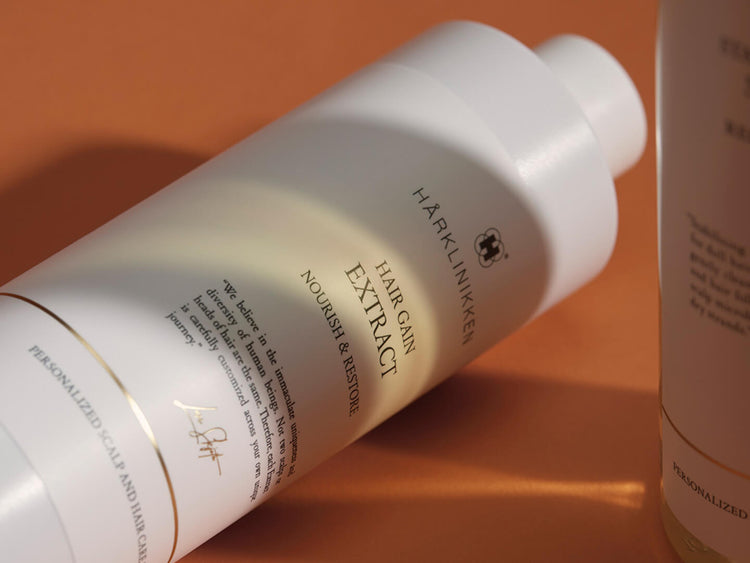While many new year resolutions can be daunting, extreme, corny, or trivial, some can be genuinely transformative – and easy to abide by. If you’re concerned about hair thinning or loss, or you want to improve the strength and lustre of your strands, Hårklinikken founder Lars Skjøth has six simple DOs and DON’Ts for better scalp and hair health. “The advice in these resolutions is impactful, but very easy for most people to incorporate into their lives,” he says. Follow these tips and make 2024 the year you elevate your routine to achieve optimal scalp health and denser, stronger, shinier hair.
Wash Correctly and Frequently
A regular and consistent cleansing routine is necessary to maintain good scalp and hair health – otherwise the sebum produced in the hair follicle can cause buildup, irritation, and even inflammation. Washing your scalp every day (or every other day) is the ideal frequency – with the right products. Gentle yet effective, both our Scalp Stabilizing Shampoo and Balancing Shampoo work to not only cleanse but also optimise conditions for scalp health and hair growth. “We're creating ideal hair health. That health is shine, lustre, fullness, and a balanced scalp microbiome, which is the real approach to healthy hair,” Skjøth says.
Keep Hair Hydrated
"Hydrating strands with the right products and in the right way means healthier, more elastic hair,” Skjøth says. “Hair with increased elasticity is stronger, more lustrous and less prone to breakage.” This means always using conditioner after shampooing, applying hair masks once or twice a week, and avoiding products that coat the hair with problematic ingredients. Many products on the market are formulated with silicones, waxes and oils that coat the hair, so while your hair might look shiny, it’s only cosmetic. To properly treat your hair, we recommend using our Daily Conditioner, Hair Hydrating Crème and Hair Mask.
Use Heat Protectant
The heat from hot styling tools impacts strands, often resulting in hair becoming dry, brittle, and damaged. It’s important to create a barrier between your hair and that heat by applying a heat protectant before blow drying, curling, or straightening. “We don’t encourage using heat on your hair every day,” says Skjøth. “But when you do, a heat protectant is crucial to protect and hydrate your strands.” Hårklinikken’s leave-in Hair Hydrating Crème protects against heat damage while also reducing frizz and increasing lustre.
Don’t Sleep With Wet Hair
Going to bed with wet hair (and wearing a hat or scarf over wet hair) creates the ideal environment for bacteria and fungus thrive. These imbalances can promote various scalp problems including dandruff, dermatitis, or folliculitis. “The scalp's micro-environment must be in balance to produce the best circumstances for optimal hair growth. When it’s wet, it skews the balance,” Skjøth says. “But also, since hair is most fragile when wet, sleeping with damp hair can potentially lead to more breakage as you move around on your pillow throughout the night.” Ultimately, it’s better to skip a wash day rather than go to bed with clean, but wet hair.
No More Dry Shampoo
While it’s called dry shampoo, these products are not shampoos or cleansers at all. Dry shampoos – used as a quick fix between washes to absorb excess oil from the scalp and hair – can create or worsen scalp issues. While they create the illusion of recently cleansed hair, they often incorporate ingredients like starch, talc, silica, clay, charcoal, baking soda, alcohol and more. These constituents can clog hair follicles and throw off the scalp’s pH balance, meaning continued use of dry shampoo may cause dermatitis and even hair loss or hair thinning. “We should just stay away from all of them in general,” Skjøth says.
Avoid Tight Hair Styles
Traction alopecia is a type of hair loss from repeated, tight hair pulling. Prolonged wear of styles such as super-slick buns, taut braids and tight ponytails will create tension between the hair and the follicle. This tension can cause the hair follicle to tear. Repeated tearing can develop scars in the follicle and this damage can prevent hair from ever growing there again. “The less you wear your hair in these styles, the less damage you will do,” Skjøth explains. “When putting your hair into a braid, bun or ponytail, try to loosen it around the roots by about half an inch.” The general rule: if you can feel your style pulling at the scalp, it’s too tight.

Unsure where to start?
We only accept candidates who we believe we can help, which is why our online Hair Assessment is the best place to start. Based on your results, you will either qualify for immediate treatment or we will organize a consultation.






